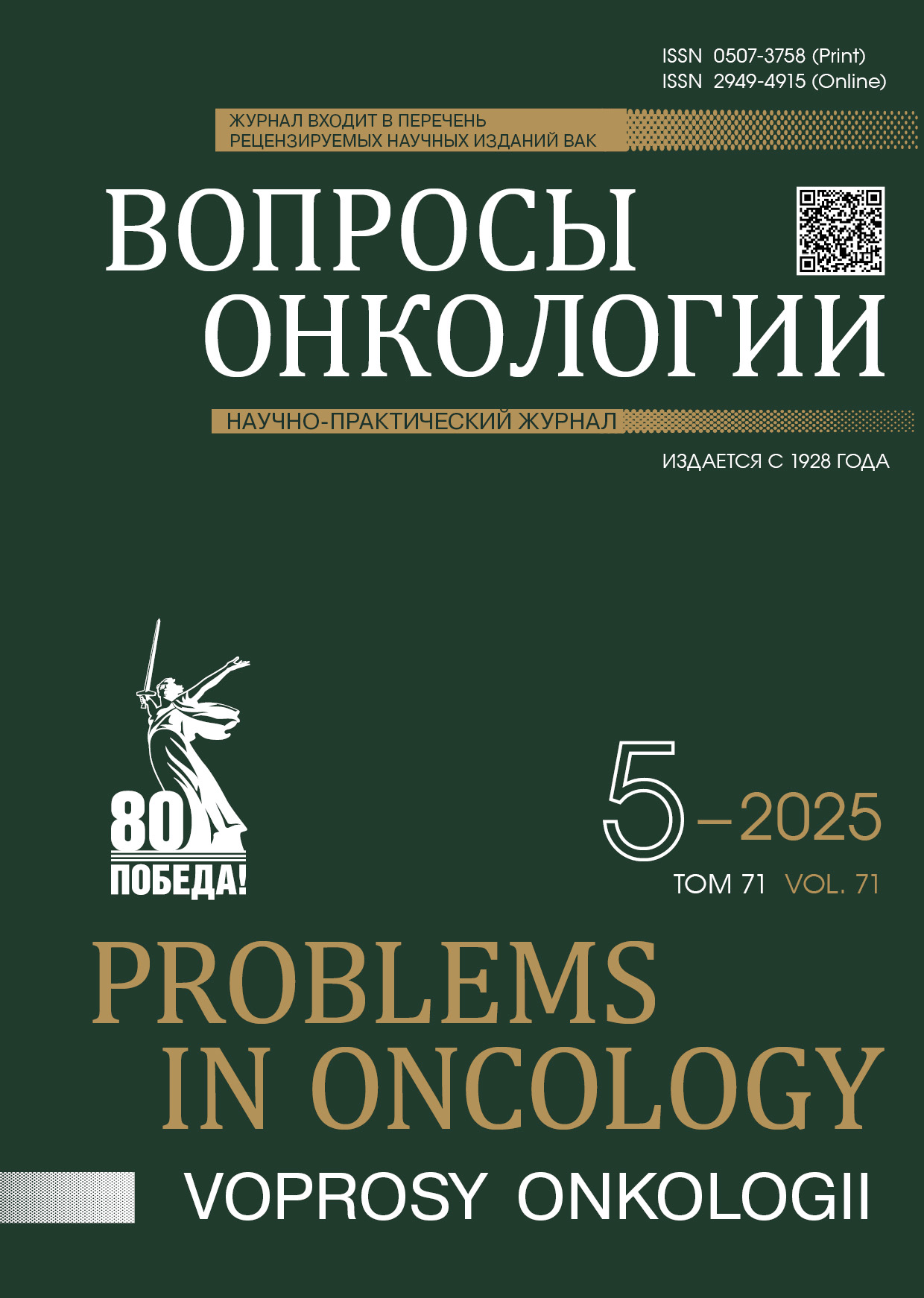Abstract
Introduction. Radiation therapy is the treatment for locally advanced cervical cancer, typically involving a course of external beam chemoradiotherapy followed by a brachytherapy boost. The brachytherapy phase critically influences local control outcomes, making strict adherence to its technical requirements essential.
Aim. Clinical practice in some centers involves using a fixed brachytherapy plan, created during the first session, for the entire intracavitary treatment course. This study evaluates the clinical applicability of using a fixed brachytherapy treatment plan—developed during the first fraction—for subsequent fractions without replanning. The analysis focuses on two key dosimetric parameters: target volume coverage by the prescribed dose and adherence to organ-at-risk dose constraints.
Materials and Methods. We analyzed 42 brachytherapy fractions from 10 patients with locally advanced cervical cancer (stages IIB–IIIC).
Results. The first-fraction treatment plan proved applicable for subsequent fractions in 9 of 10 patients, maintaining adequate target coverage. One patient with extensive tumor infiltration of the uterine body required replanning due to target underdosage. The following dose constraint violations for organs at risk were observed: bladder dose exceeded limits in one patient (requiring replanning), sigmoid colon constraints were exceeded in four patients (requiring plan modification), and half of all patients showed minor intestinal dose exceedances.
Conclusion. Fixed-plan brachytherapy appears feasible for selected patients with small target volumes (<30–33 cm³), favorable distance between organs at risk and the radiation source, satisfactory patient compliance, and confidence in the patient's adherence to pretreatment preparation protocols.
References
Каприн А.Д., Старинский В.В., Шахзадова А.О. Злокачественные новообразования в России в 2023 году (заболеваемость и смертность). М: МНИОИ им. П.А. Герцена-филиал ФГБУ «НМИЦ радиологии» Минздрава России. 2024: 276.-ISBN: 978-5-85502-298-8.-URL: http://oncology-association.ru/wp-content/uploads/2024/08/zis-2023-elektronnaya-versiya.pdf. [Kaprin A.D., Starinsky V.V., Shakhzadova A.O. Malignant neoplasms in russia in 2023 (incidence and mortality). Moscow: P.A. Herzen Moscow State Medical Research Institute - branch of the Federal State Budgetary Institution ‘NMRC of Radiology’ of the Ministry of Health of Russia. 2024: 276.-ISBN: 978-5-85502-298-8.-URL: http://oncology-association.ru/wp-content/uploads/2024/08/zis-2023-elektronnaya-versiya.pdf (in Rus)].
Wang K., Wang J., Jiang P. High-dose-rate three-dimensional image-guided adaptive brachytherapy (3D IGABT) for locally advanced cervical cancer (LACC): A narrative review on imaging modality and clinical evidence. Curr Oncol. 2023; 31(1): 5065.-DOI: https://doi.org/10.3390/curroncol31010004.
Рак шейки матки. Kлинические рекомендации Министерства здравоохранения РФ. 2024.- URL: https://cr.minzdrav.gov.ru/preview-cr/5543. [Cervical cancer: Clinical recommendations of the Ministry of Health of the Russian Federation. 2024.-URL: https://cr.minzdrav.gov.ru/preview-cr/5543 (in Rus)].
Cancer cervical cancer. National Comprehensive Cancer Network (NCCN). 2025.-URL: https://www.nccn.org.
Lin Y., Chen K., Lu Z., et al. Intensity-modulated radiation therapy for definitive treatment of cervical cancer: a meta-analysis. Radiat Oncol. 2018; 13(1): 177.-DOI: https://doi.org/10.1186/s13014-018-1126-7.
Potter R., Tanderup K., Kirisits C., et al. EMBRACE Collaborative Group. The EMBRACE II study: The outcome and prospect of two decades of evolution within the GEC-ESTRO GYN working group and the EMBRACE studies. Clin Transl Radiat Oncol. 2018; 9: 48-60.-DOI: https://doi.org/10.1016/j.ctro.2018.01.001.
Sturdza A., Potter R., Fokdal L.U., et al. Image guided brachytherapy in locally advanced cervical cancer: Improved pelvic control and survival in RetroEMBRACE, a multicenter cohort study. Radiother. Oncol. 2016; 120: 428-433.-DOI: https://doi.org/10.1016/j.radonc.2016.03.011.
Дубинина А.В., Козлов О.В., Черных М.В. Планирование брахитерапии местнораспространенного рака шейки матки по кт-изображениям. Онкогинекология. 2021; 4 (40): 50-57.-DOI: https://doi.org/10.52313/22278710_2021_4_50. [Dubinina A.V., Kozlov O.V., Chernykh M.V. Planning Of brachytherapy for locally advanced cervical cancer based on ct scan images. Gynecologic Oncology. 2021; 4 (40): 50-57.-DOI: https://doi.org/10.52313/22278710_2021_4_50 (in Rus)].
Tanderup K., Fokdal L.U., Sturdza A., et al. Effect of tumor dose, volume and overall treatment time on local control after radiochemotherapy including MRI guided brachytherapy of locally advanced cervical cancer. Radiother Oncol. 2016; 120(3): 441-446.-DOI: https://doi.org/10.1016/j.radonc.2016.05.014.
Кравец О., Романова Е., Козлов О., et al. Трехмерное планирование брахитерапии местнораспространенного рака шейки матки по КТ /МРТ изображениям. Вопросы онкологии. 2018; 64(5): 645–650.-DOI: https://doi.org/10.37469/0507-3758-2018-64-5-645-650. [Kravets O., Romanova E., Kozlov O., et al three-dimensional planning of brachytherapy for locally advanced cervical cancer by CT/MRI images. Voprosy Onkologii = Problems in Oncology. 2018; 64(5): 645–650.-DOI: https://doi.org/10.37469/0507-3758-2018-64-5-645-650 (in Rus)].
Uezono H., Tsujino K., Inoue Y., et al. CT-based image-guided brachytherapy in uterine cervical cancer: Effect of tumor dose and volume on local control. Brachytherapy. 2022; 21(6): 814-822.-DOI: https://doi.org/10.1016/j.brachy.2022.08.012.

This work is licensed under a Creative Commons Attribution-NonCommercial-NoDerivatives 4.0 International License.
© АННМО «Вопросы онкологии», Copyright (c) 2025

